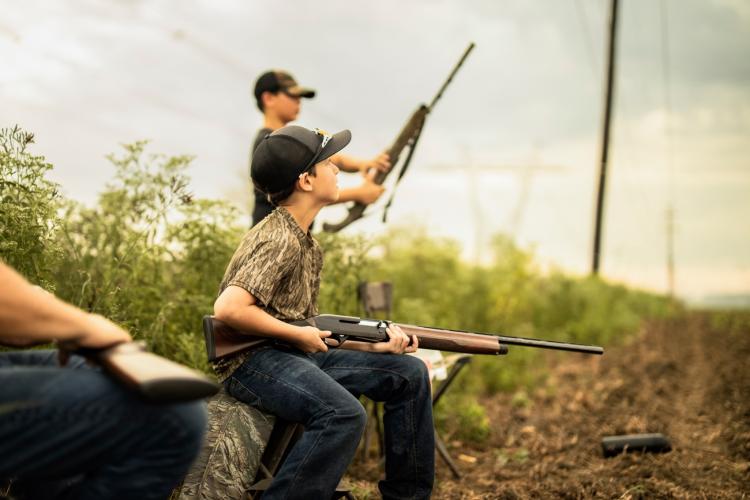HOW TO LEAD A DOVE
I believe the most important factor in taking doves is determining lead. My philosophy is to start the lead at the head of the bird instead of behind the bird. Most people miss doves, because they shoot behind the birds. When the target (the dove) is presented to the hunter in a crossing fashion (flying from right to left or left to right), many hunters have heard that more lead is required to successfully down the bird and that the Butt, Belly, Beak System of Aiming to determine the lead on a dove is the best way to harvest those birds.
Even though that system may work on fairly-close targets, it won’t produce an effective lead on doves at a distance. The Butt, Belly, Beak System of Aiming dictates that the hunter starts to swing his shotgun, coming from behind the bird, past the butt, belly and beak of the dove, and continuing to swing as he or she pulls the trigger. This style of leading a dove also is called the Pass-Through System of determining lead and works really well on flushing birds like pheasants and quail that are usually quartering away from you. However, it’s not as productive when you are shooting doves.
Instead, when you prepare to shoot at a dove, concentrate your attention and focus on the head of the bird. This system takes some practice, because most of our lives we generally have looked at the entire bodies of birds in flight. But, if you can narrow your focus to only look at the head of the dove, then once you get your gun to your shoulder, start your swing with your bead on the head of the bird to help you get a better lead.
When you begin with your bead on the bird’s head, you already have your gun moving at the same rate of speed as the dove. When the lead feels right, continue to move the gun forward past the bird’s head. Squeeze the trigger on your shotgun, and continue to move it forward. Your gun barrel doesn’t need to stop after you squeeze the trigger, because the bird doesn’t stop. Remember, the farther the bird is away from you, the more you will have to lead the bird. And, the faster the bird flies, the more you have to lead the bird. This style is called Pull Away.
BEST WAYS TO PRACTICE FOR DOVE HUNTS
Shoot sporting-clay courses before opening day of dove season. Most dove hunters don’t think about hunting or shooting doves until opening day. I once wrote an article titled, “The Outdoor Social Crowd,” because dove hunting tends to be an outdoor social event, as much as it is a hunting event. Usually a great dinner is served before the hunt and possibly after the hunt, and shooters enjoy the camaraderie and fellowship there. Many of these hunters often have very-little experience at actually shooting doves.
If you don’t have an opportunity to go to a sporting-clay range, then at least practice mounting your gun a week or two before dove season. After a dove shoot, many dove hunters have black, blue and green shoulders, because they haven’t mounted their shotguns correctly. A proper gun mount is never a mount to the shoulder. The front hand should push the gun forward and move the stock to the base of your cheek bone at the same time, which will cause the stock to fit directly on your shoulder. Mounting the gun this way enables you to hold the shotgun more still as you make the swing.
One of the biggest mistakes I see a dove hunter make is to bring his gun to his shoulder and move his head around like a bobble-head doll, while trying to find the place his cheek is supposed to be on his stock before he takes the shot. The head has to be still on the stock when you squeeze the trigger to aim properly. For instance, when you are making a golf swing, you want your head to stay still, until the club hits the ball. In baseball, when you have your bat ready to strike the ball, and the ball is coming to you, you want your head to be still, until the bat makes contact with the ball. The same is true when you mount a gun to take a dove. You want your head to be still and steady, as the gun comes to your cheek. Then your cheek and the gun lock together as one, and you can shoot more accurately.
If you push the gun toward the bird, the stock will come up naturally and correctly to the face. However, you don’t want to push the gun toward the bird too fast, so that the stock comes away from the shoulder. The stock needs to ride up the shirt until it comes in contact with the hunter’s cheek and shoulder. Remember that the rear sight on a shotgun is your eye. A correct gun mount brings the eye and the bead on the shotgun in line, just like the rear sight and the front sight on a rifle have to be lined-up correctly to make an accurate shot.
Marty Fischer
Editor’s Note: Marty Fischer is a professional wingshooter, a National Sporting Clays Association Level III shooting instructor and a longtime Mossy Oak ProStaff member, is known as America’s leading gun-club designer, having designed more than 150 sporting-clay facilities.








